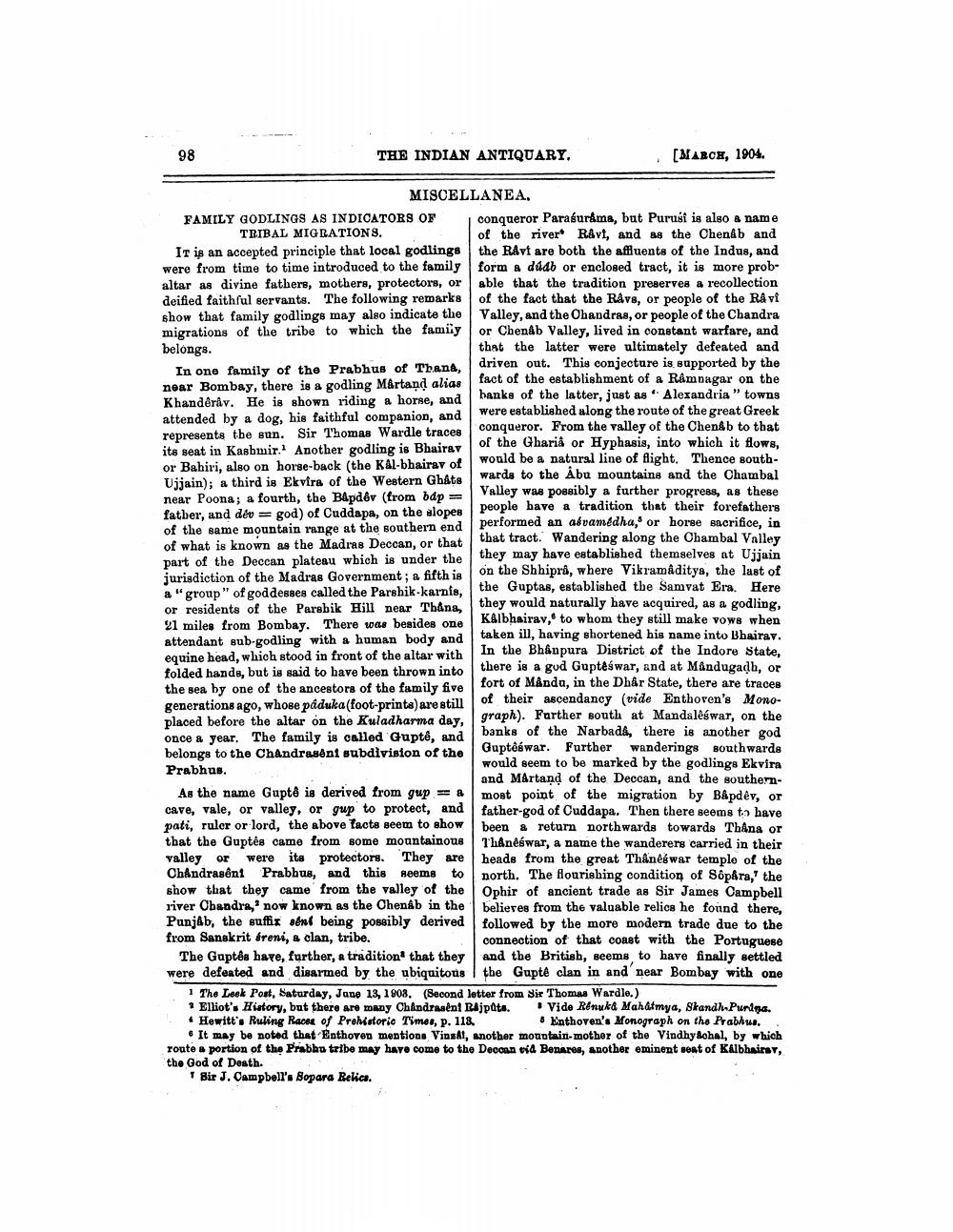________________
98
THE INDIAN ANTIQUARY.
MISCELLANEA.
FAMILY GODLINGS AS INDICATORS OF TRIBAL MIGRATIONS.
It is an accepted principle that local godlings were from time to time introduced to the family altar as divine fathers, mothers, protectors, or deified faithful servants. The following remarks show that family godlings may also indicate the migrations of the tribe to which the family belongs.
In one family of the Prabhus of Thana, near Bombay, there is a godling Martand alias Khandêrâv. He is shown riding a horse, and attended by a dog, his faithful companion, and represents the sun. Sir Thomas Wardle traces its seat in Kashmir. Another godling is Bhairav or Bahiri, also on horse-back (the Kål-bhairav of Ujjain); a third is Ekvira of the Western Ghats near Poona; a fourth, the Bâpdêv (from bap father, and dév god) of Cuddapa, on the slopes of the same mountain range at the southern end of what is known as the Madras Deccan, or that part of the Deccan plateau which is under the jurisdiction of the Madras Government; a fifth is a "group" of goddesses called the Parshik-karnis, or residents of the Parshik Hill near Thana, 21 miles from Bombay. There was besides one attendant sub-godling with a human body and equine head, which stood in front of the altar with folded hands, but is said to have been thrown into the sea by one of the ancestors of the family five generations ago, whose paduka (foot-prints) are still placed before the altar on the Kuladharma day, once a year. The family is called Gupté, and belongs to the Chandraseni subdivision of the
Prabhus.
As the name Guptê is derived from gup = a cave, vale, or valley, or gup to protect, and pati, ruler or lord, the above facts seem to show that the Guptês came from some mountainous valley or were its protectors. They are Chandraseni Prabhus, and this seems to show that they came from the valley of the river Chandra, now known as the Chenâb in the Punjab, the suffix sent being possibly derived from Sanskrit éreni, a clan, tribe.
[MARCH, 1904.
conqueror Parasurama, but Purusi is also a name of the river Râvt, and as the Chenâb and the RAvi are both the affluents of the Indus, and form a dúdb or enclosed tract, it is more probable that the tradition preserves a recollection of the fact that the Râvs, or people of the Râvi Valley, and the Chandras, or people of the Chandra or Chenâb Valley, lived in constant warfare, and that the latter were ultimately defeated and driven out. This conjecture is supported by the fact of the establishment of a Râmnagar on the banks of the latter, just as Alexandria" towns were established along the route of the great Greek conqueror. From the valley of the Chenab to that of the Ghariâ or Hyphasis, into which it flows, would be a natural line of flight. Thence southwards to the Abu mountains and the Chambal Valley was possibly a further progress, as these people have a tradition that their forefathers performed an aévamedha, or horse sacrifice, in that tract. Wandering along the Chambal Valley they may have established themselves at Ujjain on the Shhiprâ, where Vikramaditya, the last of the Guptas, established the Samvat Era. Here they would naturally have acquired, as a godling, Kalbhairav, to whom they still make vows when taken ill, having shortened his name into Bhairav. In the Bhanpura District of the Indore State, there is a god Gupteswar, and at Mândugadh, or fort of Måndu, in the Dhar State, there are traces of their ascendancy (vide Enthoven's Monograph). Further south at Mandalêswar, on the banks of the Narbada, there is another god Guptêéwar. Further wanderings southwards would seem to be marked by the godlings Ekvira and Martand of the Deccan, and the southernmost point of the migration by Bâpdêv, or father-god of Cuddapa. Then there seems to have been a return northwards towards Thâna or Thânêéwar, a name the wanderers carried in their heads from the great Thânêéwar temple of the north. The flourishing condition of Sôpâra," the Ophir of ancient trade as Sir James Campbell believes from the valuable relics he found there, followed by the more modern trade due to the connection of that coast with the Portuguese and the British, seems to have finally settled the Gupté clan in and near Bombay with one
The Guptes have, further, a tradition that they were defeated and disarmed by the ubiquitous
1 The Leek Post, Saturday, June 13, 1908. (Second letter from Sir Thomas Wardle.)
2 Elliot's History, but there are many Chandrasênt Rajputs.
Vide Renuka Mahatmya, Skandh-Puriga. Enthoven's Monograph on the Prabhus.
Hewitt's Ruling Races of Prehistoric Times, p. 118.
It may be noted that Enthoven mentions Vinsal, another mountain-mother of the Vindhyachal, by which route a portion of the Prabhu tribe may have come to the Deccan vid Benares, another eminent seat of Kalbhairav, the God of Death.
Bir J. Campbell's Sopara Relics.




